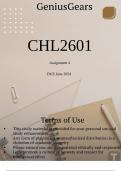CHL2601
Assignment 4
DUE June 2024
, Introduction
Children’s literature has undergone significant transformation from
its early origins, where it was primarily seen as a tool for moral and
educational instruction, to a diverse and multifaceted field that
embraces a wide range of themes, genres, and purposes. Initially,
the primary objective of children's books was to impart moral
lessons and religious values, reflecting the societal norms and
educational priorities of the time. However, over the centuries,
children’s literature has expanded to include stories that entertain,
inspire, and provide young readers with a broader understanding of
the world around them.
In this discussion, we will trace the evolution of children’s literature
from its didactic beginnings to its current form, highlighting key
developments and influential works that have shaped its trajectory.
We will also delve into the elements of a story using a specific
example from children’s literature, examining how character, setting
plot, theme, conflict, and point of view are employed to create
compelling narratives that engage and educate young readers. This
analysis will provide a comprehensive understanding of the dynami
nature of children’s literature and its enduring impact on young
minds.
, DISCLAIMER
This comprehensive document offers a detailed analysis, providing
valuable insights and explanations for students seeking to deepen their
understanding. It’s clear and concise explanations make it an invaluable
study resource, helping students grasp complex concepts with ease. With
well-organized sections and illustrative examples, the document caters to
various learning styles, making it accessible to a wide range of students.
The inclusion of practice questions and exercises enhances its utility,
allowing students to reinforce their knowledge and test their
comprehension. Whether used for exam preparation or as a supplementary
learning aid, this document equips students with the tools they need to
succeed academically in this unit.
, lOMoARcPSD|41752181
Children's Literature
, lOMoARcPSD|41752181
Question 1 [25]
1.1 Below are Piaget’s four stages of cognitive development, labelled from A to D. following
these stages are ten test items. Based on your knowledge of cognitive development,
categorise the test items according to the most appropriate stage of development. (15)
A. Sensorimotor stage
B. Pre-operational stage
C. Concrete operational stage
D. Formal operational stage
i. construct and understand the world around them through their senses
ii. beginning to understand symbolic representation
iii. egocentric and think that the world revolves around their needs iv. adolescents and
adults v. enjoy stories in which animals and inanimate objects can talk
vi. start to use logic
vii. require security and comfort viii. enjoy books that offer moral dilemmas
ix. begin to understand interpersonal conflict and use books to help them to understand the
self
x. worry about peer acceptance and find comfort in books that deal with friendship among
peers
xi. establishment of personal, social and cultural identity
xii. non-toxic and washable books
xiii. graded readers
xiv. enjoy predictable stories and rhythmical rhymes
xv. can classify books according to criteria and enjoy concept books




